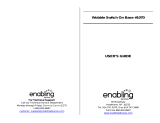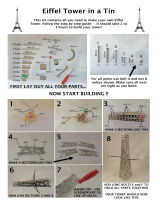
Wissenswertes für ElternInteresting facts for parents
32
DEAR PARENTS,
Would you like your junior world explorer
to get interested in building blocks? Are
you looking for new challenges to present
to already experienced stacking artists?
With Clever-Up! you have made the right
choice, because this building block system
will keep you and your child pleasantly
occupied for many hours.
Clear, simple shapes allow for many different
combinations and inspire imagination and
cre ativity. The building blocks, baseplates
and slats can be used to bridge gaps as
well as to add ramps and floors to the main
structure. Children enjoy experimenting
with the blocks, lining them up and stacking
them on top of each other. They gradually
learn how to create ever more complex archi
-
tectural designs and take pride in producing
realistic structures.
Aspiring master builders can be left to their
own devices as they construct their very own
version of the Eiffel Tower, or similar, in their
bedroom or the living room. See how your
child grows and develops in terms of ideas
and projects. You can help out too, because
it is so much more fun when family and
friends join in.
Gravity, balance, momentum – what do
they mean? Here you will find child-friendly
ex planations of simple physical and mathe
-
matical relationships. Playful tasks introduce
children to the mental skills that are increa
-
singly necessary in a digital world.
Have fun building, experimenting, playing
and learning with the Clever-Up! building
block system.
Your HABA team
INFO:
COMMUNICATING SUPPORT
Talk to your child about their ideas, offer encourage-
ment and celebrate their successes. By answering
their questions, you generate a constructive atmos-
phere. In this way, your child will feel understood
and gain the con fidence to keep trying.
Why is it good for children
to play with wooden building blocks?
Building blocks combine the fun of building and playing
with worthwhile learning experiences. They are toys that
are essentially simple while at the same time complex, and
they stimulate motor skills, cognitive capacity and creativity.
Building and understanding
The HABA building block system accompanies your child from
basic discovery and experimentation in the baby months to
an all-round understanding of construction principles. It does
so by promoting their development in a playful manner.
The variety of templates in the brochure inspire your child
to design their own buildings. Give children time and space,
and they will become absorbed by their very own projects,
branching out in new directions, sometimes for days on end.
In the process, they will develop their eye-hand coordination,
fine motor skills, powers of concentration and endurance.
You will be amazed at all the things your child learns;
ingenious stackers explore the length, height and depth of
the given space. In this way, children learn basic physical laws
such as statics, inertia, cause and effect as well as balance.
Learning through play
In free play with the building block system, your child learns
how to plan independently and naturally acquires problem-
solving skills. By integrating the building blocks into varied
role-playing games, your child develops his or her dexterity
and language skills. Your child learns how to process feelings,
engage on a social level, deal with established procedures
and devise his or her own rules of play.

























